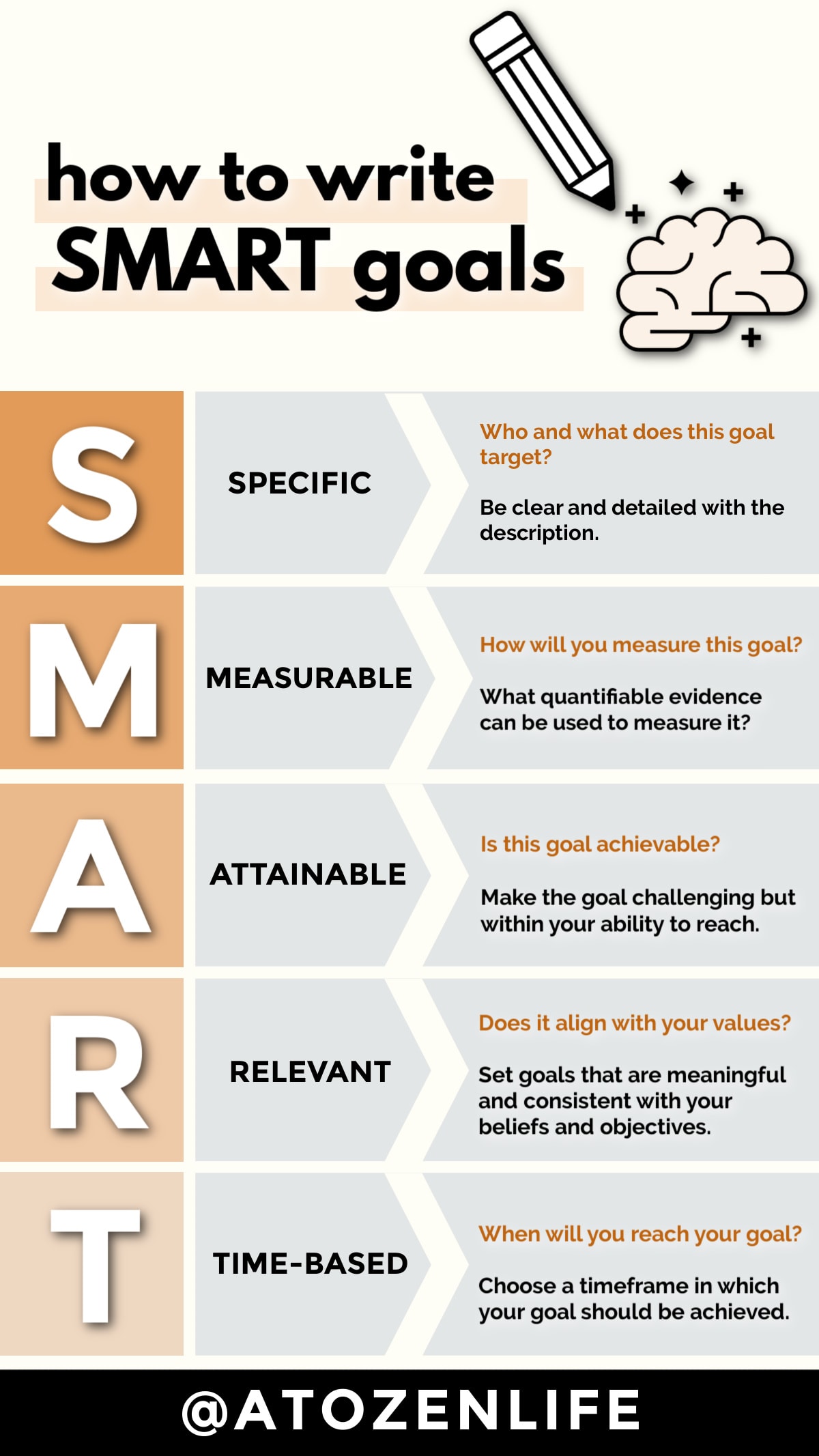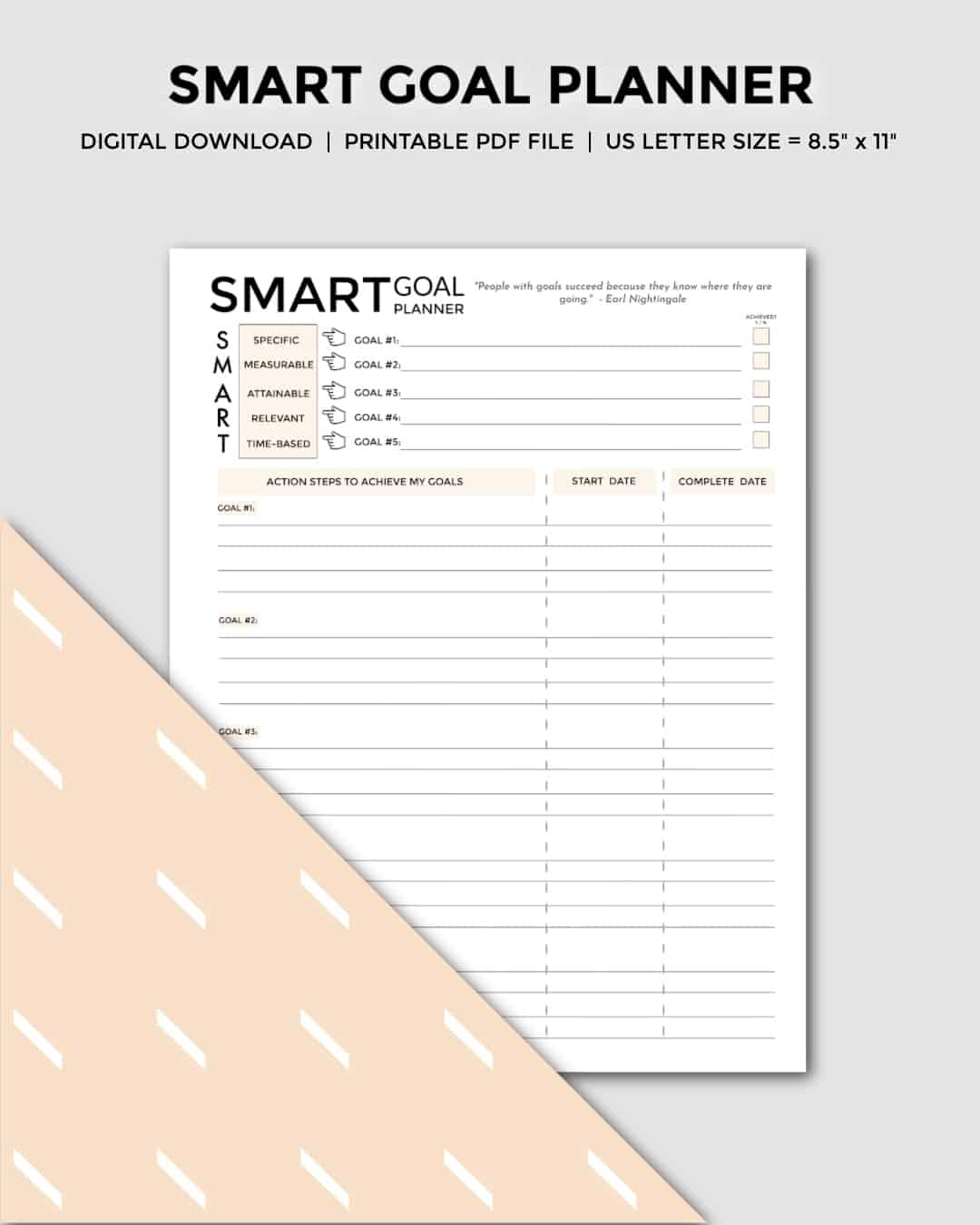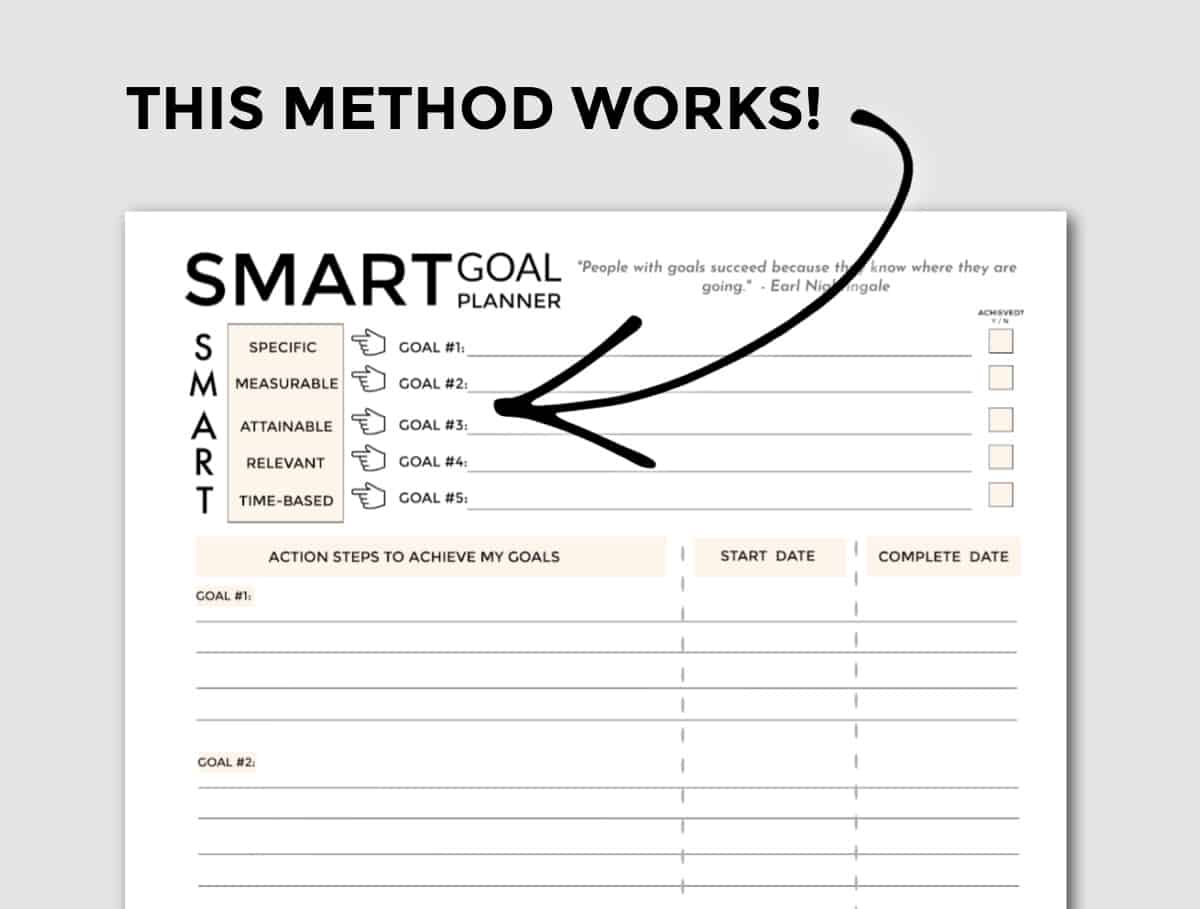How to Write SMART Goals: 35 Examples + Template [PDF]
This post may contain affiliate links for your convenience. That means that if you make a purchase, I will receive a small commission at no extra cost to you. Read more here.
Do you have a set of personal or professional goals that you want to achieve? If so, it’s time to find out how to write SMART goals! Today’s objective is for you to discover what a SMART goal is, the right way to write SMART goals, and get plenty of helpful SMART goal examples you can copy yourself.
There’s also a printable SMART goals template available at the end of this post, which you can download and print in the comfort of your own home.
READ MORE: 30 Ambition Quotes to Awaken Your True Potential

What are SMART goals?
What makes a SMART goal well, smart?
As it turns out, the power reveals itself right there in the name! The secret to the success of the smart goal is spelled out in the acronym S.M.A.R.T.
SMART goals were first described in the November 1981 issue of Management Review by George T. Doran in a paper called, “There’s a S.M.A.R.T. way to write management’s goals and objectives“, which discussed the importance of objectives and the difficulties of setting them. (Wikipedia)
This acronym means:
- S = Specific
- M = Measurable
- A = Attainable or achievable
- R = Relevant
- T = Time-based
While SMART goals are the bread and butter of entrepreneurs and businesses, the average person can also benefit from learning how to set SMART goals for almost any aspect of their life!

How to write SMART goals?
Let’s break down each section of the SMART goal acronym even further and discuss how to write SMART goals.
Specific
The first step in writing a smart goal is to define the specific goal you are targeting.
After all, it’s hard to meet a goal when you’re aren’t clear on exactly what you are trying to achieve!
Consider this your goal’s mission statement and ask yourself two essential wh- questions: who will do what?
- Who is this goal for? Is it for an individual or a group? Does reaching the goal benefit a person or a business or objective? A personal goal for self-improvement may look very different than a goal that you set for your business.
- What needs to be done? The more specific and concrete, the better; dig down and determine the goal’s target. A poor example would be: I want to lose weight. A better goal is: I want to lose ten pounds.
READ MORE: Top 20 Be Yourself Quotes to Embrace the Skin You’re In!
Measurable
It’s hard to measure progress towards a goal if you don’t have a good way to track how far you are on the path to achieving it.
It helps to look at cold, hard facts when measuring your goals.
If you’re targeting weight loss, like in the example above, you will use a scale to determine how much you weigh.
Setting measurable goals for other areas can be trickier but not impossible!
Here are more examples of how to measure SMART goals:
- If you want to save more money, you can create a monthly budget or target a certain amount of savings each week.
- If you want to read more, you might set a specific amount of books to read in 30 days.
- If you want to learn to speak a foreign language, you might set a goal to study for 30 minutes each day.
READ MORE: How to Do No Spend Challenge to Save Money [PDF]
Attainable
The next SMART goal criterion is attainable. This means that your goals should be realistic and achievable based on your current situation, abilities, and resources.
It’s nice to dream big, but don’t make your goals so impossible that they are beyond your reach!
While it’s possible to learn how to speak a new language, saying that you want to be fluent in Mandarin Chinese in three months is a stretch. It would take an average person around 50 weeks of consistent study to reach an intermediate level, and I speak from experience by saying it’s tough!
Setting achievable goals helps keep you motivated to keep working towards them. If the goals you’ve set seem too far out of reach, you are going to get discouraged and be more likely to give up.
Set your goals high enough to inspire you and low enough to keep you encouraged.
“You will achieve your grand dream, a day at a time, so set goals for each day.”
– Og Mandino
READ MORE: How to Make a Vision Board That ACTUALLY Works!
Relevant
Now it’s time to consider the relevancy of your goal. Does your goal align with the direction you want to take and your values, interests, skills, and abilities?
Be intentional and set goals that are relevant to the bigger picture so you know you’re putting effort into actions and steps that push you toward your long-term objectives.
BE INSPIRED: 100 Ways to Simplify Your Life and Be Happier
Time-based
It’s human nature to want things and want them fast!
While you can’t expect to set a goal and have it materialize out of the ether right away, it does help to determine a clear timeframe in which you want to reach your goals.
Therefore, your SMART goal should have a time-based aspect. A nebulous goal that’s set without a clear time boundary is often too far in the distant future to maintain focus and motivation.
Setting time boundaries also helps reduce stress and overwhelm since you’re less likely to procrastinate when you have a step-by-step timeline.

SMART Goals Examples
Regardless of your professional or personal goals, you can feel confident that you’ll reach your goals using the SMART goal method.
If you want more goal examples, check out this post with 100 personal goals to set, and then you can write smart goals to target each one!
SMART Goals example for students
- I will maintain a 3.75 GPA for each semester of college that I attend.
- I will dedicate two hours to studying each day of the week (and weekends as necessary).
- I will complete my homework at least one day before it is due to reduce overwhelm and procrastination.
- I will check in with my teachers every month to identify and target areas of weakness.
- I will turn off my smartphone 30 minutes before bedtime each night and get eight hours of sleep to improve my health and focus.
SMART Goals example for career
- I will receive a promotion to a managerial position by the end of this year.
- I will update my resume and apply to three new jobs per week until I find one I like.
- I will increase my income by $10,000 in one year via promotion or switching jobs.
- In three months, I will increase my typing speed from 40 words per minute (average) to 50 words per minute (fast) through online exercises and 30 minutes of practice a day.
- I will create or update my LinkedIn profile to connect and cultivate relationships in my field by the end of this month.
SMART Goals example for health
- I will lose ten pounds in three months.
- I will drink eight 16 oz glasses of water each day.
- I will eat three healthy meals and one snack per day.
- I will complete 30-45 minutes of cardiovascular and/or strength training three times a week.
- I will meditate for 15 minutes a day on my own or by using a meditation app to focus.
READ MORE: 10 Toxic Fantasy Self Items to Declutter in RIGHT NOW!
SMART Goals examples for getting a job
- I will find a joy that pays $50,000 a month within two months of graduating.
- I will create a master list of 20 locations and companies I want to work at and apply to all of them two months before graduating.
- At the start of my final semester, I will finish writing my resume and get it checked by at least two people (ask a teacher, if possible).
- I will apply to five jobs per week starting eight weeks before graduating and participating in interviews as they arise.
- I will attend the school career fair and bring 30 copies of my resume to hand out to recruiters.
SMART Goals examples for personal growth
- I will read one new book on self-development each month of this year.
- I will be able to hold a 5-minute conversation in Spanish after six months of daily study for 30 minutes per day.
- I will speak at two public events per month to improve my public speaking and presentation skills.
- I will spend 20 minutes on a daily journaling practice and reflecting on what I’ve written.
- I will volunteer my time or money twice a month to charities or community service this year.
SMART Goals examples for personal finance
- I will save $120,000 for a downpayment on a home by the time I’m 23 years old.
- I will track all of my expenses and spending for 30 days to get better at budgeting.
- I will write a budget plan that helps me save 50% of my income each month.
- I will participate in one no-spend challenge every three months and put the money I save towards paying off debt.
- I will start a side hustle that makes an extra $500 a month within six months by spending two hours each day on it.
READ MORE: 80 End of Year Quotes to Inspire and Motivate You
SMART Goals examples for home and family
- We will have dinner together as a family for 5/7 days of the week.
- We will play a board game together every Saturday night.
- We sit down together and create a bucket list of ten things that we want to do together as a family this year by the end of January.
- Each family member will complete their daily and weekly chores according to the chore chart posted in the kitchen.
- We will declutter our entire home by the end of six months by following a printable plan and targeting 2-3 categories per month.
BE INSPIRED: 20 Things to Let Go of to Be Happier & Live Better
Final thoughts on SMART goals
If you’re struggling to create SMART goals, I hope you found this how-to guide helpful!
If you want even more help, you might find this SMART goals worksheet useful; print and fill it out to ensure your goals are specific, measurable, achievable, relevant, and time-bound.
GRAB IT NOW: I’ve created a free SMART Goals Template PDF for you to download! Click here to get it >> SMART GOALS TEMPLATE.

